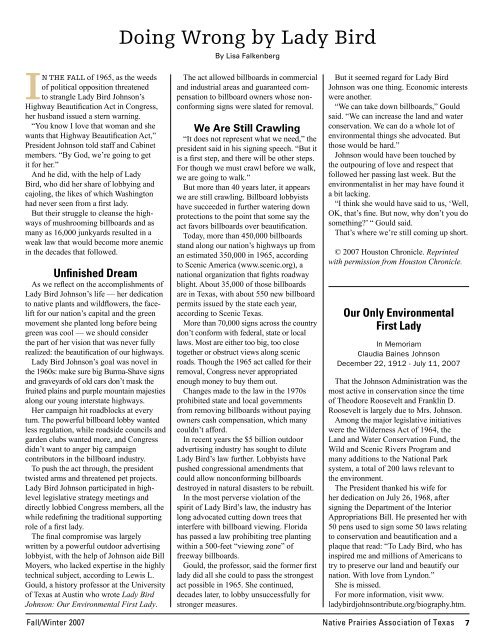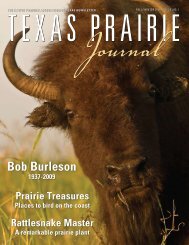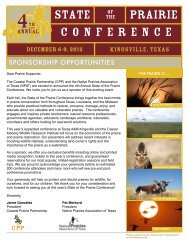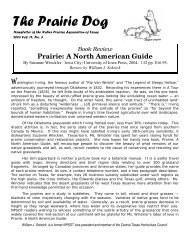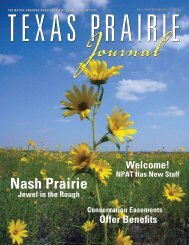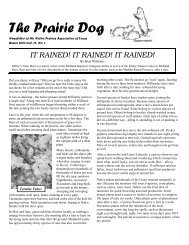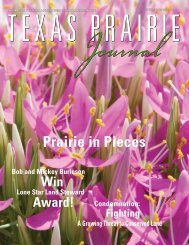2007 Fall/Winter issue - Native Prairies Association of Texas
2007 Fall/Winter issue - Native Prairies Association of Texas
2007 Fall/Winter issue - Native Prairies Association of Texas
Create successful ePaper yourself
Turn your PDF publications into a flip-book with our unique Google optimized e-Paper software.
Doing Wrong by Lady Bird<br />
By Lisa Falkenberg<br />
In the fall <strong>of</strong> 1965, as the weeds<br />
<strong>of</strong> political opposition threatened<br />
to strangle Lady Bird Johnson’s<br />
Highway Beautification Act in Congress,<br />
her husband <strong>issue</strong>d a stern warning.<br />
“You know I love that woman and she<br />
wants that Highway Beautification Act,”<br />
President Johnson told staff and Cabinet<br />
members. “By God, we’re going to get<br />
it for her.”<br />
And he did, with the help <strong>of</strong> Lady<br />
Bird, who did her share <strong>of</strong> lobbying and<br />
cajoling, the likes <strong>of</strong> which Washington<br />
had never seen from a first lady.<br />
But their struggle to cleanse the highways<br />
<strong>of</strong> mushrooming billboards and as<br />
many as 16,000 junkyards resulted in a<br />
weak law that would become more anemic<br />
in the decades that followed.<br />
Unfinished Dream<br />
As we reflect on the accomplishments <strong>of</strong><br />
Lady Bird Johnson’s life — her dedication<br />
to native plants and wildflowers, the facelift<br />
for our nation’s capital and the green<br />
movement she planted long before being<br />
green was cool — we should consider<br />
the part <strong>of</strong> her vision that was never fully<br />
realized: the beautification <strong>of</strong> our highways.<br />
Lady Bird Johnson’s goal was novel in<br />
the 1960s: make sure big Burma-Shave signs<br />
and graveyards <strong>of</strong> old cars don’t mask the<br />
fruited plains and purple mountain majesties<br />
along our young interstate highways.<br />
Her campaign hit roadblocks at every<br />
turn. The powerful billboard lobby wanted<br />
less regulation, while roadside councils and<br />
garden clubs wanted more, and Congress<br />
didn’t want to anger big campaign<br />
contributors in the billboard industry.<br />
To push the act through, the president<br />
twisted arms and threatened pet projects.<br />
Lady Bird Johnson participated in highlevel<br />
legislative strategy meetings and<br />
directly lobbied Congress members, all the<br />
while redefining the traditional supporting<br />
role <strong>of</strong> a first lady.<br />
The final compromise was largely<br />
written by a powerful outdoor advertising<br />
lobbyist, with the help <strong>of</strong> Johnson aide Bill<br />
Moyers, who lacked expertise in the highly<br />
technical subject, according to Lewis L.<br />
Gould, a history pr<strong>of</strong>essor at the University<br />
<strong>of</strong> <strong>Texas</strong> at Austin who wrote Lady Bird<br />
Johnson: Our Environmental First Lady.<br />
The act allowed billboards in commercial<br />
and industrial areas and guaranteed compen<br />
sation to billboard owners whose nonconforming<br />
signs were slated for removal.<br />
We Are Still Crawling<br />
“It does not represent what we need,” the<br />
president said in his signing speech. “But it<br />
is a first step, and there will be other steps.<br />
For though we must crawl before we walk,<br />
we are going to walk.”<br />
But more than 40 years later, it appears<br />
we are still crawling. Billboard lobbyists<br />
have succeeded in further watering down<br />
protections to the point that some say the<br />
act favors billboards over beautification.<br />
Today, more than 450,000 billboards<br />
stand along our nation’s highways up from<br />
an estimated 350,000 in 1965, according<br />
to Scenic America (www.scenic.org), a<br />
national organization that fights roadway<br />
blight. About 35,000 <strong>of</strong> those billboards<br />
are in <strong>Texas</strong>, with about 550 new billboard<br />
permits <strong>issue</strong>d by the state each year,<br />
according to Scenic <strong>Texas</strong>.<br />
More than 70,000 signs across the country<br />
don’t conform with federal, state or local<br />
laws. Most are either too big, too close<br />
together or obstruct views along scenic<br />
roads. Though the 1965 act called for their<br />
removal, Congress never appropriated<br />
enough money to buy them out.<br />
Changes made to the law in the 1970s<br />
prohibited state and local governments<br />
from removing billboards without paying<br />
owners cash compensation, which many<br />
couldn’t afford.<br />
In recent years the $5 billion outdoor<br />
advertising industry has sought to dilute<br />
Lady Bird’s law further. Lobbyists have<br />
pushed congressional amendments that<br />
could allow nonconforming billboards<br />
destroyed in natural disasters to be rebuilt.<br />
In the most perverse violation <strong>of</strong> the<br />
spirit <strong>of</strong> Lady Bird’s law, the industry has<br />
long advocated cutting down trees that<br />
interfere with billboard viewing. Florida<br />
has passed a law prohibiting tree planting<br />
within a 500-feet “viewing zone” <strong>of</strong><br />
freeway billboards.<br />
Gould, the pr<strong>of</strong>essor, said the former first<br />
lady did all she could to pass the strongest<br />
act possible in 1965. She continued,<br />
decades later, to lobby unsuccessfully for<br />
stronger measures.<br />
But it seemed regard for Lady Bird<br />
Johnson was one thing. Economic interests<br />
were another.<br />
“We can take down billboards,” Gould<br />
said. “We can increase the land and water<br />
conservation. We can do a whole lot <strong>of</strong><br />
environmental things she advocated. But<br />
those would be hard.”<br />
Johnson would have been touched by<br />
the outpouring <strong>of</strong> love and respect that<br />
followed her passing last week. But the<br />
environmentalist in her may have found it<br />
a bit lacking.<br />
“I think she would have said to us, ‘Well,<br />
OK, that’s fine. But now, why don’t you do<br />
something’ “ Gould said.<br />
That’s where we’re still coming up short.<br />
© <strong>2007</strong> Houston Chronicle. Reprinted<br />
with permission from Houston Chronicle.<br />
Our Only Environmental<br />
First Lady<br />
In Memoriam<br />
Claudia Baines Johnson<br />
December 22, 1912 - July 11, <strong>2007</strong><br />
That the Johnson Administration was the<br />
most active in conservation since the time<br />
<strong>of</strong> Theodore Roosevelt and Franklin D.<br />
Roosevelt is largely due to Mrs. Johnson.<br />
Among the major legislative initiatives<br />
were the Wilderness Act <strong>of</strong> 1964, the<br />
Land and Water Conservation Fund, the<br />
Wild and Scenic Rivers Program and<br />
many additions to the National Park<br />
system, a total <strong>of</strong> 200 laws relevant to<br />
the environment.<br />
The President thanked his wife for<br />
her dedication on July 26, 1968, after<br />
signing the Department <strong>of</strong> the Interior<br />
Appropriations Bill. He presented her with<br />
50 pens used to sign some 50 laws relating<br />
to conservation and beautification and a<br />
plaque that read: “To Lady Bird, who has<br />
inspired me and millions <strong>of</strong> Americans to<br />
try to preserve our land and beautify our<br />
nation. With love from Lyndon.”<br />
She is missed.<br />
For more information, visit www.<br />
ladybirdjohnsontribute.org/biography.htm.<br />
<strong>Fall</strong>/<strong>Winter</strong> <strong>2007</strong><br />
native <strong>Prairies</strong> <strong>Association</strong> <strong>of</strong> <strong>Texas</strong><br />
7


